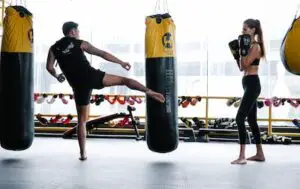In the world of martial arts, kickboxing is a popular combat sport that combines punches, kicks, and knee strikes. However, there are different styles of kickboxing, each with their own techniques, tactics, and rules. Dutch style kickboxing, also known as Muay Thai kickboxing, has gained a reputation as one of the most aggressive and effective fighting styles. If you’re a martial arts enthusiast or a fighter looking to improve your skills, you might be wondering what sets Dutch style kickboxing apart from other styles. In this article, we’ll explore the key features of Dutch style kickboxing and its benefits for fighters.
What is Dutch Style Kickboxing?
Dutch style kickboxing originated in the Netherlands in the 1970s and 1980s, when Dutch fighters started competing in traditional Muay Thai matches in Thailand. They adapted the Thai techniques to fit their own fighting style, adding more hand strikes, footwork, and combinations. Dutch style kickboxing emphasizes speed, power, and efficiency, and is usually more aggressive and offensive than other kickboxing styles. Unlike traditional Muay Thai, which focuses on the clinch and elbow strikes, Dutch style kickboxing allows more footwork and lateral movement.
What Are the Key Techniques of Dutch Style Kickboxing?
Dutch style kickboxing involves a wide range of punches, kicks, knee strikes, and clinch techniques. Here are some of the most common techniques used in Dutch style kickboxing:
1. Jab: The jab is a quick and straight punch thrown with the lead hand. It’s used to set up other strikes or to keep the opponent at bay.
2. Cross: The cross is a powerful punch thrown with the rear hand. It’s usually preceded by a jab or a feint and can knock the opponent out or set up a follow-up strike.
3. Hook: The hook is a horizontal punch thrown with the lead or rear hand. It’s used to attack the opponent’s head or body from the side.
4. Uppercut: The uppercut is an upward punch thrown from the inside. It’s used to target the opponent’s chin or solar plexus and can be followed by a hook or cross.
5. Low kick: The low kick is a leg kick aimed at the opponent’s thigh or calf. It’s used to damage the opponent’s base and slow them down.
6. High kick: The high kick is a kick aimed at the opponent’s head or neck. It’s used to knock the opponent out or set up other strikes.
7. Knee strike: The knee strike is a strike using the knees to the stomach or leg of the opponent, could result in grave injuries.
What Are the Advantages of Dutch Style Kickboxing?
Dutch style kickboxing has several advantages for fighters, including:
1. Improved striking speed and power: Dutch style kickboxing emphasizes quick and powerful strikes, which can help fighters knock out their opponents or score points in tournaments.
2. Enhanced footwork and mobility: Dutch style kickboxing allows more lateral movement and footwork, which can help fighters avoid attacks or set up their own strikes.
3. Effective defense techniques: Dutch style kickboxing includes defensive techniques such as blocking, slipping, and parrying, which can help fighters avoid strikes and create counterattacks.
4. Improved physical fitness and conditioning: Dutch style kickboxing is a high-intensity workout that can improve cardiovascular endurance, strength, and agility.
5. A better understanding of Muay Thai techniques: Dutch style kickboxing is derived from Muay Thai kickboxing, so practicing it can help fighters learn the techniques and tactics used in traditional Thai fighting.
6. Increased confidence and mental toughness: Dutch style kickboxing teaches fighters to overcome their fears, stay focused under pressure, and develop a fighter’s mindset.
What Are the Differences Between Dutch Style Kickboxing and Other Kickboxing Styles?
Dutch style kickboxing differs from other kickboxing styles in several ways:
1. Traditional Muay Thai: Traditional Muay Thai includes more clinching techniques, elbow strikes, and knee strikes than Dutch style kickboxing. Muay Thai fighters also wear different gloves and have different scoring rules.
2. American kickboxing: American kickboxing emphasizes fast and powerful punches, but does not allow knee strikes or clinching. It also has different scoring rules and allows different types of gloves.
3. Savate: Savate is a French kickboxing style that uses footwork, kicks, and punches. Unlike Dutch style kickboxing, Savate does not include knee strikes or clinching techniques.
4. K-1 kickboxing: K-1 kickboxing is a Japanese kickboxing style that was popular in the 1990s and 2000s. It combines Muay Thai, karate, and boxing techniques and allows knee strikes and clinching. K-1 also has different rules and weight classes than Dutch style kickboxing.
What Are the Rules of Dutch Style Kickboxing?
The rules of Dutch style kickboxing vary depending on the organization or tournament. Generally, the rules include:
1. Use of gloves: Fighters wear gloves that weigh between 8 and 10 ounces, depending on their weight class.
2. Eight-count rule: If a fighter is knocked down, the referee will count to eight before allowing the fighter to continue.
3. No strikes to the back of the head or groin: Fighters are not allowed to strike their opponents in the back of the head or groin.
4. Clinching: Depending on the rules, fighters may be allowed to clinch for a limited amount of time. Knees or rising elbows charges could lead to serious harm and could force the match to an end.
5. Scoring: Fighters earn points for clean strikes, knockdowns, and overall performance. The scoring system varies by organization.
What Are Some Famous Dutch Style Kickboxers?
Dutch style kickboxing has produced some of the most successful and famous kickboxers in the world. Some of the most notable Dutch style kickboxers include:
1. Ramon Dekkers: Considered one of the greatest kickboxers of all time, Dekkers won multiple Muay Thai and kickboxing titles, including the K-1 World Grand Prix.
2. Ernesto Hoost: Hoost won four K-1 World Grand Prix titles and is known for his powerful low kicks and aggressive fighting style.
3. Semmy Schilt: Schilt is a four-time K-1 World Grand Prix champion and is known for his tall height and devastating knee strikes.
4. Gokhan Saki: Saki won the K-1 World Grand Prix in 2008 and is known for his fast and powerful striking.
5. Rico Verhoeven: Verhoeven is the current GLORY heavyweight champion and has won multiple kickboxing titles, including the K-1 World Grand Prix.
Conclusion
Dutch style kickboxing is a dynamic and aggressive fighting style that can benefit fighters of all levels. By emphasizing speed, power, and efficiency, Dutch style kickboxing can help fighters improve their striking abilities, footwork, and defense techniques. Although similar to Muay Thai kickboxing in some ways, Dutch style kickboxing has its own techniques, rules, and famous fighters. Whether you’re a martial arts enthusiast or a professional fighter, Dutch style kickboxing is a valuable style to add to your training regimen.





